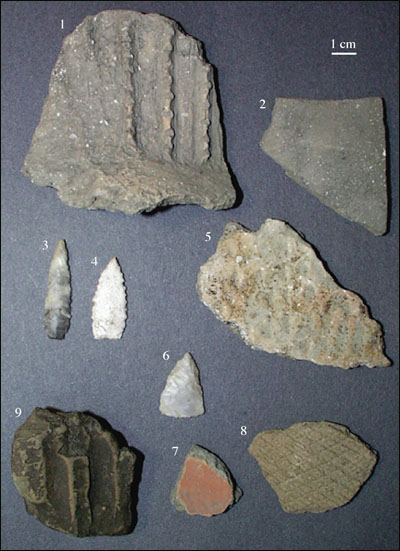 |
|
The lower Mississippi River Valley was a fertile homeland to Native Americans from about 9500 B.C. to 1670 A.D. The presence of Native Americans is still evident today in the occasional mound not yet destroyed by modern agricultural practices and the abundant potsherds, lithic tools and points, and bone fragments found in plowed fields and river and ditch cutbanks. Most artifacts encountered during studies of New Madrid sand blows are from the Woodland and Mississippian cultures, which thrived from about 200 B.C. to 1000 A.D. and 800 to 1670 A.D., respectively. Both cultural periods are subdivided into early, middle, and late intervals. Woodland ceramics are characterized by grog (ground up potsherds or fired clay) and sand tempering; whereas, Mississippian ceramics are characterized by shell tempering. Although there are uncertainties regarding their age ranges, certain pottery and point types, as well as plant remains, are considered diagnostic of various cultural periods. For example, Bell Plain, Campbell Appliqué, and Parkin Punctate pottery and Nodena points are diagnostic of the Late Mississippian period; Old Town Red pottery and Madison points are diagnostic of the Middle Mississippian period; Varney Red Filmed pottery is diagnostic of the Early Mississippian period; and Barnes pottery and Table Rock stemmed points are diagnostic of the Late Woodland period. Zea maize, or corn, became dominant in the Native American diet about 1000 to 1050 A.D. and is as an important temporal marker in the region.
Photograph of some diagnostic artifact types in New Madrid region: 1, Campbell Appliqué; 2, Bell Plain; 3, Nodena Elliptical point; 4, Nodena Banks variety point; 5, Parkin Punctate; 6, Madison point; 7, Varney Red Filmed; 8, Barnes Cord Marked; 9, daub with wattle impression. Click to download a PDF file showing cultural periods, time spans, and associated diagnostic artifacts. Archeology has played an important role in recognizing and dating prehistoric earthquake-induced liquefaction features in
the New Madrid region. Sand blows found below Native American mounds and occupation horizons no doubt formed prior to 1811
because few Native Americans lived in the area after the 17th Century. Diagnostic artifacts found in association with sand
blows provide a preliminary estimate of the age of the causative earthquake. Detailed investigations can further constrain
the age of the event. For example, artifacts in an occupation horizon buried by a sand blow can provide an estimate of the
maximum age of the liquefaction feature; whereas, artifacts in an horizon developed in the top of a sand blow can provide an
estimate of its minimum age. Similarly, plant remains and other organics found in cultural horizons can be used to
date associated sand blows. Radiocarbon dating of plant remains is the most commonly used dating technique in paleoseismology.
It is preferable to have radiocarbon dates from both overlying and underlying horizons to bracket the age of the sand blow.
Log of trench wall at Dodd site near Steele, Missouri, where sand blow and two associated sand dikes are exposed. The pre-event ground surface was displaced downward by 70 to 80 cm between the two sand dikes. Late Mississippian ceramic artifacts found above and below sand blow suggest that it formed between 1400 and 1670 A.D. Radiocarbon dating of charcoal in the soil horizon buried by the sand blow indicates that it formed after 1290 A.D. Radiocarbon dating of a corn kernel collected from a wall trench dug into the top of the sand blow indicates that it formed before 1460 A.D. Therefore, the estimated age of the sand blow is 1290-1460 A.D. |
| M. Tuttle & Associates: P.O. Box 345, Georgetown ME 04548 • mptuttle@earthlink.net |

